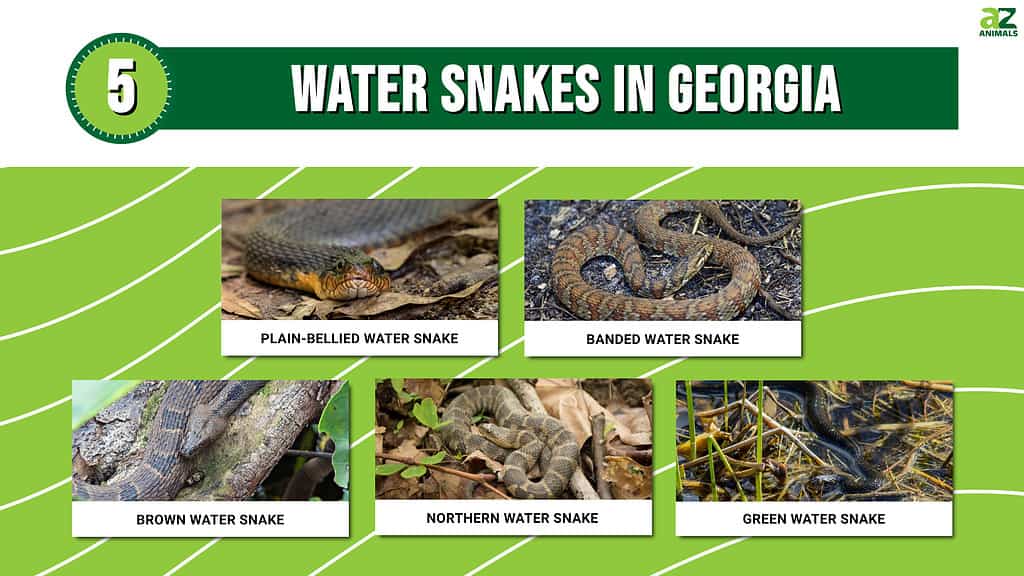
While Georgia is home to many unique and fascinating animals, some of the most diverse and adaptable animals are snakes. Although they can live in virtually any habitat, easily some of the most fascinating snakes are water snakes. Water snakes are nonvenomous snakes from the genus Nerodia, in which there are nine species found across North America. Of these, five species are native to Georgia. Although cottonmouths, crayfish snakes, and swamp snakes are all also found in water, only these five are true water snakes. So, join us as we discover the water snakes in Georgia!
1. Plain-Bellied Water Snake

Plain-bellied water snakes are found in every southeastern state of the US. These snakes (Nerodia erythrogaster) are 24 to 40 inches long. They have thick bodies and are usually brown, green, gray, or black on their dorsal side. However, their bellies are always a plain, solid color – usually yellow or reddish-orange – which is where they get their common name from. There are six subspecies of plain-bellied water snakes. Their color tends to differ slightly depending on the subspecies and their location.
Plain-bellied water snakes always live near permanent water sources – such as ponds, swamps, streams, lakes, rivers, and floodplains. Despite being water snakes, they tend to spend quite a lot of time out of the water – more so than the other water snakes do. However, they rely on the water for their food and eat mainly frogs, salamanders, fish, and crayfish. They also have a number of predators both in and out of the water. Their main predators are kingsnakes, largemouth bass, cottonmouths, and hawks.
2. Banded Water Snake
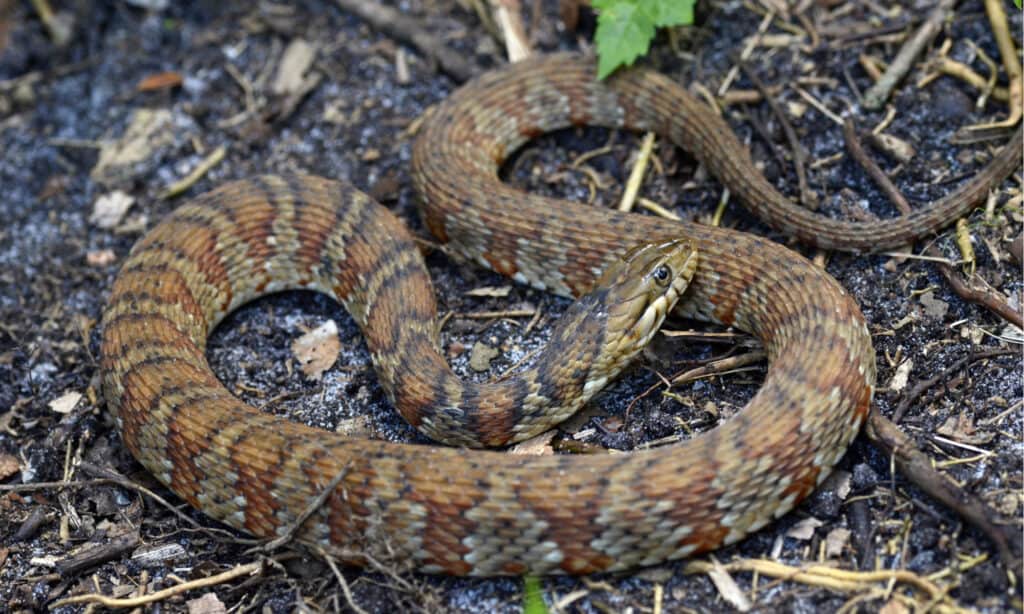
Banded water snakes have unique crossband markings, hence their name.
©Patrick K. Campbell/Shutterstock.com
Although they are also known as southern water snakes, banded water snakes are named for their crossband markings. These snakes (Nerodia fasciata) are 22 to 42 inches long. They are typically brown, gray, or greenish-gray with darker markings. However, the markings sometimes become indiscernible as the snake darkens with age. They also have a light yellow or cream-colored belly, which sometimes has red or black markings. There are currently three recognized subspecies of banded water snakes. Banded water snakes have also been known to breed with northern water snakes to produce hybrid offspring.
Banded water snakes live in shallow freshwater habitats such as streams, ponds, lakes, and swamps. Although they are most active at night, they often spend their days basking on logs near the water’s edge. Banded water snakes also rely on the water for their prey. Their diet mainly consists of frogs and fish, which are swallowed alive. However, juveniles tend to eat small fish until they are big enough to swallow frogs.
3. Brown Water Snake
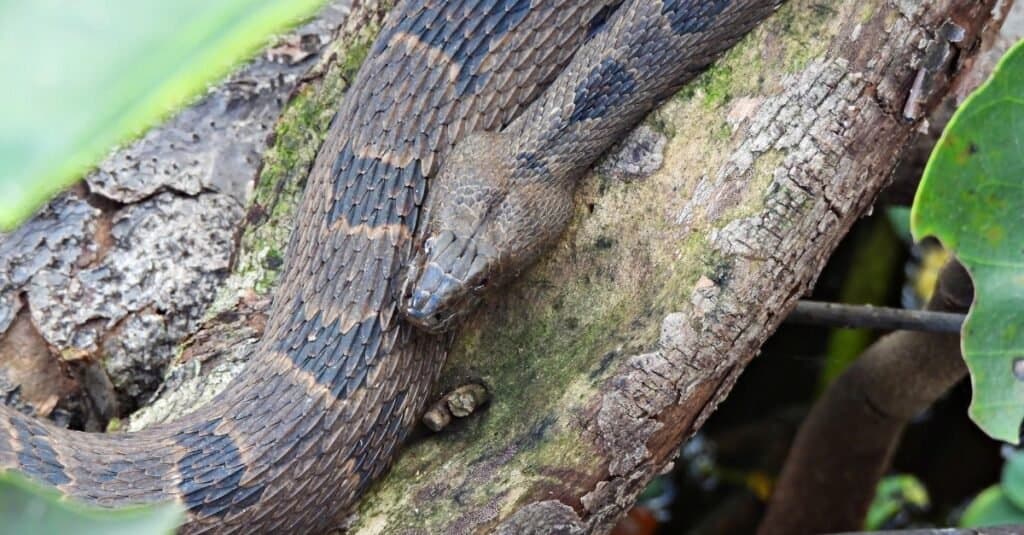
Brown water snakes have a triangular head, with the eyes being set toward the top.
©iStock.com/passion4nature
One of the most common water snakes in Georgia is the brown water snake (Nerodia taxispilota) which is endemic to the southeastern area of the United States. Brown water snakes are 30 to 60 inches long and have heavy bodies with a neck that is noticeably narrower than their head. They are predominantly brown on their dorsal side, with around 25 black or dark brown blotches down their back and smaller blotches down their sides. Their bellies are yellow with black or brown markings. Brown water snakes live in rivers, swamps, and streams in low coastal regions. They are not venomous and typically flee into the water when they are threatened. They are also excellent climbers and can be seen as high as 20 feet up in trees.
Brown water snakes are often confused with venomous cottonmouth snakes (which are known as water moccasins). The combination of their appearance and the same favored habitat as cottonmouths often leads to many brown water snakes being killed every year as a result of mistaken identity. Aside from humans, predators of brown water snakes include alligators and large birds of prey.
4. Northern Water Snake
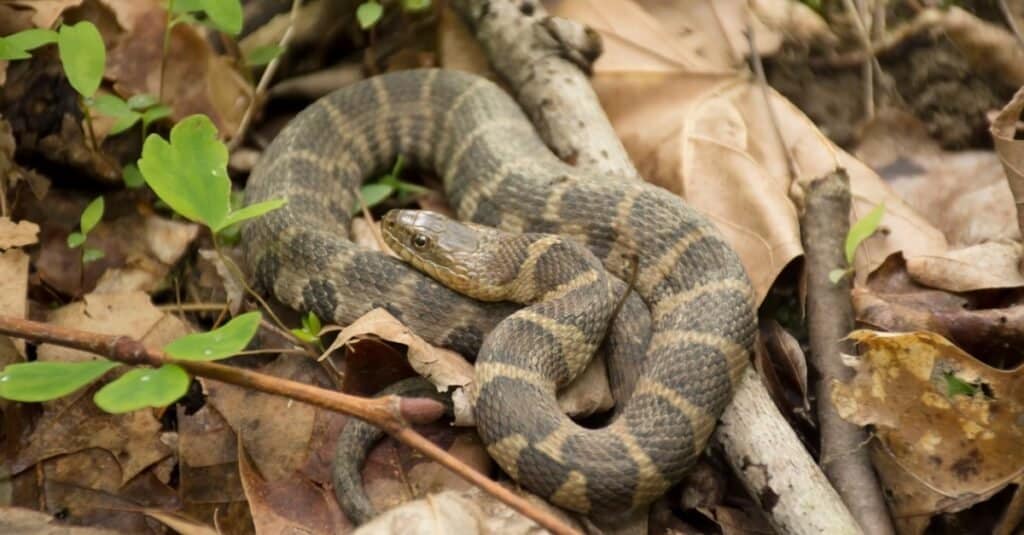
The northern water snake has a flat head that is as wide as its neck.
©iStock.com/IcemanJ
Also known as common water snakes, northern water snakes are large water snakes in Georgia that are often mistaken for venomous cottonmouths. These snakes (Nerodia sipedon) can reach lengths of almost 4.5 feet long, with females being larger than males. Northern water snakes are brown or brownish-black with dark crossband markings on their neck and blotches on their bodies. They always live near permanent water sources – such as rivers, streams, swamps, and ponds. One of their favorite ways to spend their day is basking on logs and rocks in the sun next to the water. However, they are always quick to flee back into it at the first sign of danger.
Northern water snakes mainly hunt along the water’s edge during the day, and their diet includes small fish, frogs, salamanders, birds, and mammals. They also hunt during the night, where they concentrate on small fish in the shallows. Although they are not venomous, northern water snakes can be aggressive if they are threatened. They have a unique defense mechanism whereby their saliva contains an anticoagulant that causes their bites to bleed more than normal.
5. Green Water Snake
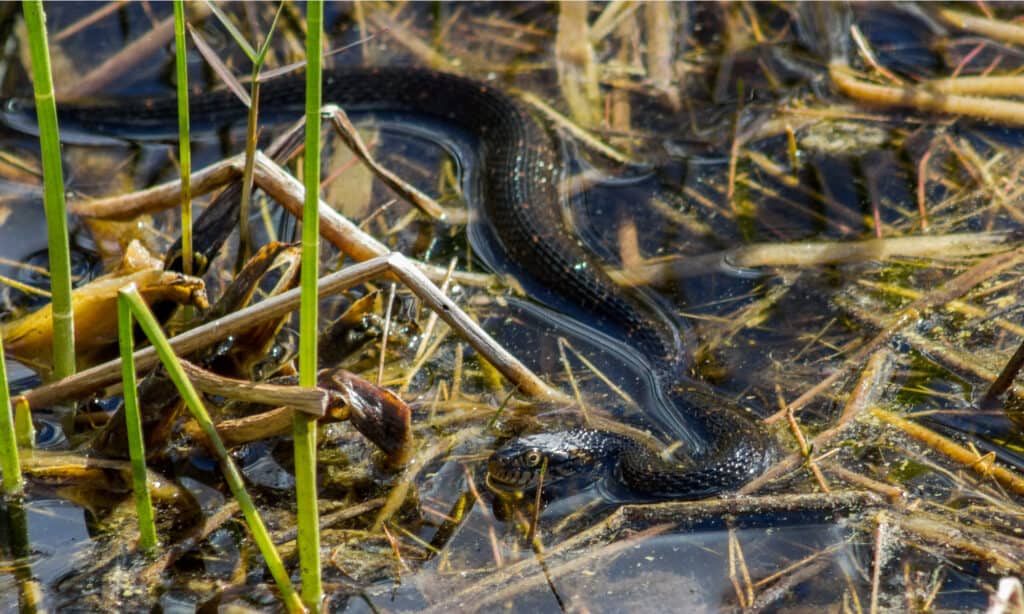
Green water snakes live in freshwater habitats where there is plenty of vegetation.
©EdwinWilke/Shutterstock.com
The final water snake in Georgia is the green water snake which is also known as the Mississippi green water snake. Green water snakes (Nerodia cyclopi) are usually between 30 and 55 inches long, and their bodies are typically a dark or olive green color. They also have darker markings down their back and sides, which disappear as they age. Green water snakes have large heads and one to three small scales underneath their eyes. A former subspecies – the Florida green water snake – is now a species of its own right and is the only other North American water snake to share the trait of having scales underneath the eyes.
Green water snakes prefer to live in still water where there is plenty of vegetation – such as lakes, ponds, swamps, ditches, and slow-moving streams. They are mainly nocturnal but like to spend the day basking near the water’s edge. These snakes are not venomous and are not constrictors, so prey is usually swallowed alive. They mainly eat fish, crayfish, and frogs, while birds and other snakes are their main predators.
What Other Similar Animals Live In Georgia?
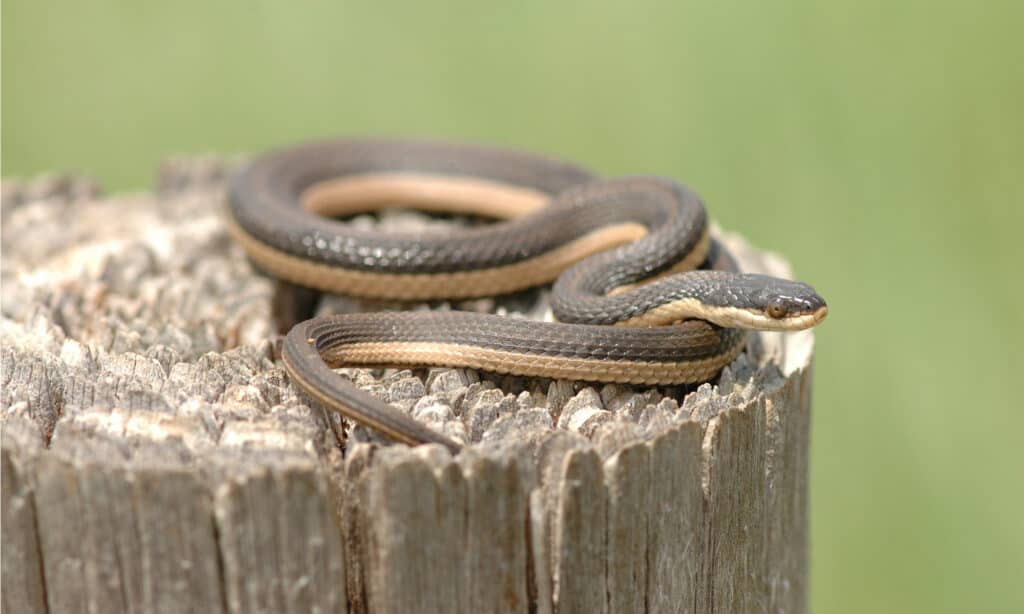
The crayfish snake is named for its mainly crustacean diet
©Rusty Dodson/Shutterstock.com
The crayfish snake (Liodytes rigida): Named for its diet of crayfish, this snake with olive-colored dorsal scales and yellow ventral scales, is capable of reaching 16 inches in length and has a stocky form. Its range exists in the southeastern United States and includes states such as Arkansas, Alabama, the Carolinas, Florida, Louisiana, Mississippi, and Virginia.

Red-spotted newts prefer to live in lakes, ponds, or streams and are also capable of producing tetrodotoxin
©iStock.com/epantha
Red-spotted newt (Notophthalmus viridescens viridescens): A small scarlet amphibian noted for its alluring red coloring, it also has orange spots surrounded by darker pigment on its skin. Capable of growing to 5 inches, it is impressively long-lived and is capable of surviving for between 12-15 years. In spite of its small size, its ability to produce the dreaded neurotoxin, tetrodotoxin enables it to deter would-be-predators including crayfish and snakes which may otherwise consider it a tasty meal.
The photo featured at the top of this post is ©
Discover the "Monster" Snake 5X Bigger than an Anaconda
Every day A-Z Animals sends out some of the most incredible facts in the world from our free newsletter. Want to discover the 10 most beautiful snakes in the world, a "snake island" where you're never more than 3 feet from danger, or a "monster" snake 5X larger than an anaconda? Then sign up right now and you'll start receiving our daily newsletter absolutely free.
Thank you for reading! Have some feedback for us? Contact the AZ Animals editorial team.







